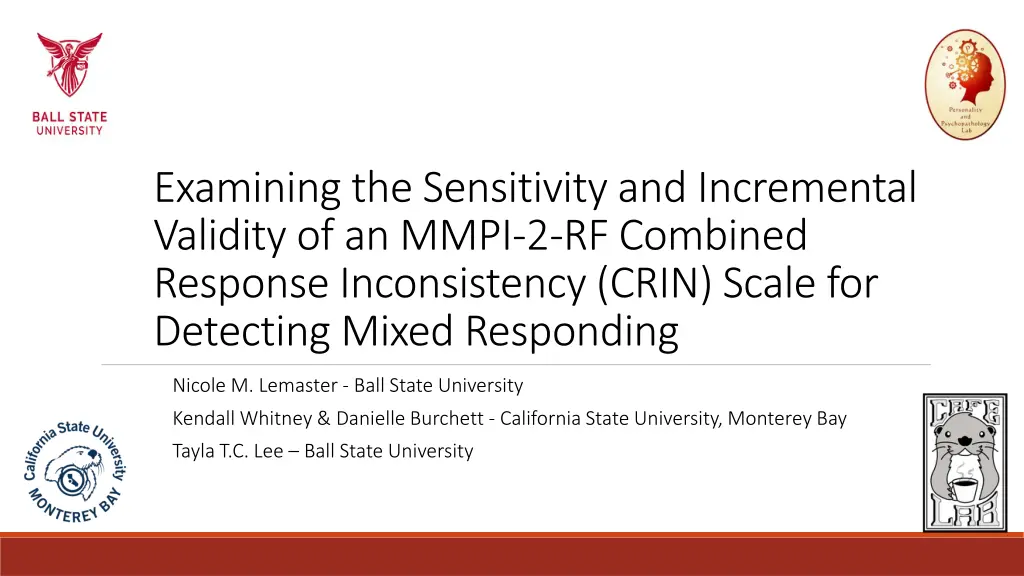
Sensitivity of MMPI-2-RF Combined Response Inconsistency Scale
Explore the sensitivity and incremental validity of the MMPI-2-RF Combined Response Inconsistency (CRIN) Scale in detecting mixed responding, a type of non-content-based response. The CRIN scale, developed on the MMPI-A-RF, serves as a global measure of non-content-based responding by assessing inconsistencies in item responses. Minimal research has been conducted on the use of CRIN on the MMPI-2-RF, making it an area of interest for further investigation.
Download Presentation

Please find below an Image/Link to download the presentation.
The content on the website is provided AS IS for your information and personal use only. It may not be sold, licensed, or shared on other websites without obtaining consent from the author. If you encounter any issues during the download, it is possible that the publisher has removed the file from their server.
You are allowed to download the files provided on this website for personal or commercial use, subject to the condition that they are used lawfully. All files are the property of their respective owners.
The content on the website is provided AS IS for your information and personal use only. It may not be sold, licensed, or shared on other websites without obtaining consent from the author.
E N D
Presentation Transcript
Examining the Sensitivity and Incremental Validity of an MMPI-2-RF Combined Response Inconsistency (CRIN) Scale for Detecting Mixed Responding Nicole M. Lemaster - Ball State University Kendall Whitney & Danielle Burchett - California State University, Monterey Bay Tayla T.C. Lee Ball State University
Mixed Responding A type of non-content based responding that includes: Random Responding Acquiescent Responding Counter-Acquiescent Responding
Combined Response Inconsistency Scale (CRIN) CRIN was developed on the MMPI-A-RF (Archer, Handel, Ben- Porath, & Tellegen, 2016) to: Augment the shortened VRIN-r and TRIN-r validity scales Serves as a global measure of non-content based responding Minimal research has been conducted for the use of CRIN on the MMPI-2-RF
CRIN Components: VRIN-r VRIN-r 53 item pairs A point is assigned when an examinee inconsistently answers a pair of items that were written in the same direction Total score = number of pairs answered inconsistently
CRIN Components: TRIN-r 26 pairs A point is assigned when an examinee inconsistently answers a pair of items that were written in the opposite direction Tug-o-War scoring TRIN-r TRIN-r 11 TRIN-r True False
CRIN Calculation on the MMPI-2-RF TRIN-r TRIN-r CRIN VRIN-r True False 53 Pairs 15 Pairs 11 Pairs
Previous Research: Whitney et al. (2018a): Calculated raw scores and Linear T Scores using the MMPI-2-RF normative sample Examined the basic properties of CRIN scale scores on the MMPI-2-RF in a forensic inpatient sample Found that scores on CRIN flagged an extra 3% of cases
Previous Research Given that CRIN scores uniquely detect cases, Whitney et al. (2018b) investigated CRIN scores ability to measure mixed responding Used computer-generated mixed responding Investigated 40% mixed responding
Current Study Replicate and extend the work of Whitney et al. (2018b) by: Investigate CRIN scores incremental validity to VRIN-r and TRIN-r scores in detecting mixed responding at a rate of 40-100% Investigate how splitting scores on TRIN-r into TRIN-r True and TRIN-r false impacts the incremental validity of CRIN score in detecting mixed responding alongside VRIN-r, TRIN-r True, and TRIN-r False
Hypotheses 1. Similar to Whitney et al. (2018b), CRIN scores will demonstrate elevations in the presences of mixed responding. 2. Scores on CRIN will incrementally add to scores on VRIN-r and TRIN-r in detecting mixed responding across all of the rates of mixed responding. 3. CRIN scores incremental utility for detecting mixed responding beyond VRIN-r and TRIN-r scores will be negatively impacted by splitting TRIN-r into TRIN-r True and TRIN-r False
Methods Participants: Stringent exclusionary criteria were used to exclude all invalid protocols (Burchett et al., 2016): CNS 15; VRIN-r 70; TRIN-r 70; F-r 79; Fp-r 70; Fs 80; FBS 80; RBS 80; L-r 65; K 60 3,298 1,781 Exclusion College Students College Students Criteria Four samples of college students were combined to form this large sample: All samples were collected at Midwestern universities between the years 2007-2018 Age: M = 19.30; SD = 2.44; Gender: 538 men, 1195 women Ethnicity: 85.9% White; 8.3% African American, 2.6% Hispanic, 1.6% Asian, 2.6% another
Methods - Procedure Replicated the methodology of Whitney et al. (2018) Used computer-generated responses to simulate mixed responding at various rates Split MMPI-2-RF into three sections Section 1: Items 1-113; Section 2: 114-226; Section 3: 227-338 Items 1-113 Items 114-226 Items 227-338 F T F T F T F T F T F T F T F T F T F T F T F T F T F T F T F T F T F T F T F T F T F T F
Methods - Procedure Replicated the methodology of Whitney et al. (2018) Used computer-generated responses to simulate mixed responding at various rates Selected designated percentage of items from each section (Ex. 40%) Items 1-113 Items 114-226 Items 227-338 F T F T F T F T F T F T F T F T F T F T F T F T F T F 40% Chosen T F T F T F T F T F T F T F T F T F
Methods - Procedure Replicated the methodology of Whitney et al. (2018) Used computer-generated responses to simulate mixed responding at various rates Selected designated percentage of items from each section (Ex. 40%) Generate random, acquiescent, or counter acquiescent responding Items 1-113 Items 114-226 Items 227-338 T F T F T F T F T F T F T F T F F T F T F T F 40% Chosen T F F T F T F T F F T F T F T F
Methods - Procedure Replicated the methodology of Whitney et al. (2018) Used computer-generated responses to simulate mixed responding at various rates Selected designated percentage of items from each section (Ex. 40%) Generate random, acquiescent, or counter acquiescent responding Items 1-113 Items 114-226 Items 227-338 T T F T F T F T F T T T F T F T F T 40% Random (True or False) F F T F T F T F T F F F T F T F T F F F T F T F T F
Methods - Procedure Replicated the methodology of Whitney et al. (2018) Used computer-generated responses to simulate mixed responding at various rates Selected designated percentage of items from each section (Ex. 40%) Generate random, acquiescent, or counter acquiescent responding Items 1-113 Items 114-226 Items 227-338 T T F T F T F T F T T T F T F T 40% Random (True or False) F F F T F T F 40% Chosen T F F F T F T F F F F T F T F
Methods - Procedure Replicated the methodology of Whitney et al. (2018) Used computer-generated responses to simulate mixed responding at various rates Selected designated percentage of items from each section (Ex. 40%) Generate random, acquiescent, or counter acquiescent responding Items 1-113 Items 114-226 Items 227-338 T T F T F T F T F T T T F T F T 40% Random (True or False) F F F T F T F 40% Chosen T F F F T F T F F F F T F T F
Methods - Procedure Replicated the methodology of Whitney et al. (2018) Used computer-generated responses to simulate mixed responding at various rates Selected designated percentage of items from each section (Ex. 40%) Generate random, acquiescent, or counter acquiescent responding Items 1-113 Items 114-226 Items 227-338 T T F T F T F T F T T T F T T T F T 40% Random (True or False) 40% Acquiescent (All True) F F T F T F T F T F F F T T T F T F F F T F T F T F
Methods - Procedure Replicated the methodology of Whitney et al. (2018) Used computer-generated responses to simulate mixed responding at various rates Selected designated percentage of items from each section (Ex. 40%) Generate random, acquiescent, or counter acquiescent responding Items 1-113 Items 114-226 Items 227-338 T T F T F T T F T T T F T T T F 40% Random (True or False) 40% Acquiescent (All True) F F T F T F T 40% Chosen T F F F T T T T F F F T F T F
Methods - Procedure Replicated the methodology of Whitney et al. (2018) Used computer-generated responses to simulate mixed responding at various rates Selected designated percentage of items from each section (Ex. 40%) Generate random, acquiescent, or counter acquiescent responding Items 1-113 Items 114-226 Items 227-338 T T F T F T T F T T T F T T T F 40% Random (True or False) 40% Acquiescent (All True) F F T F T F T 40% Chosen T F F F T T T T F F F T F T F
Methods - Procedure Replicated the methodology of Whitney et al. (2018) Used computer-generated responses to simulate mixed responding at various rates Selected designated percentage of items from each section (Ex. 40%) Generate random, acquiescent, or counter acquiescent responding Items 1-113 Items 114-226 Items 227-338 T T F T F T F T F T T T F T T T F F 40% Counter- Acquiescent (All False) 40% Random (True or False) 40% Acquiescent (All True) F F T F T F T F T F F F T T T F T F F F T F T F F F
Methods - Procedure This entire process was complete 6 different times to account for six different variations of mixed responding This was repeated across the 7 different variations in mixed responding rate (40-100%) ACR ARC RCA A = Acquiescent C = Counter-acquiescent R = Random RAC CAR CRA
Hypothesis # 1: CRIN scores will demonstrate elevation in the presence of mixed responding.
40% Mixed Responding 60% Mixed Responding 120 120 110 110 100 100 90 90 80 80 70 70 60 60 50 50 40 40 30 30 20 20 10 10 0 0 RAC RCA CAR CRA ARC ACR RAC RCA CAR CRA ARC ACR VRIN-r TRIN-r CRIN VRIN-r TRIN-r CRIN
40% Mixed Responding 60% Mixed Responding 120 120 110 110 100 100 90 90 80 80 70 70 60 60 50 50 40 40 30 30 20 20 10 10 0 0 RAC RCA CAR CRA ARC ACR RAC RCA CAR CRA ARC ACR VRIN-r TRIN-r CRIN VRIN-r TRIN-r CRIN
40% Mixed Responding 60% Mixed Responding 120 120 110 110 100 100 90 90 80 80 70 70 60 60 50 50 40 40 30 30 20 20 10 10 0 0 RAC RCA CAR CRA ARC ACR RAC RCA CAR CRA ARC ACR VRIN-r TRIN-r CRIN VRIN-r TRIN-r CRIN
40% Mixed Responding 60% Mixed Responding 120 120 110 110 100 100 90 90 80 80 70 70 60 60 50 50 40 40 30 30 20 20 10 10 0 0 RAC RCA CAR CRA ARC ACR RAC RCA CAR CRA ARC ACR VRIN-r TRIN-r CRIN VRIN-r TRIN-r CRIN
100% Mixed Responding 80% Mixed Responding 120 120 110 110 100 100 90 90 80 80 70 70 60 60 50 50 40 40 30 30 20 20 10 10 0 0 RAC RCA CAR CRA ARC ACR RAC RCA CAR CRA ARC ACR VRIN-r TRIN-r CRIN VRIN-r TRIN-r CRIN
Hypothesis # 2: Scores on CRIN will incrementally add to scores on VRIN-r and TRIN-r in detecting mixed responding across all of the rates of mixed responding.
40% Mixed Responding 100% 90% 20% 24% 37% 80% CASES NOT CASES NOT DETECTED DETECTED 41% 13% 10% 70% 61% 62% 4% 11% 60% 2% 16% 3% 16% 50% 3% 2% 2% 40% 5% 14% 30% 16% 59% 53% 2% 1% 43% 20% 6% 3% 36% 10% 18% 17% 0% RAC RCA CAR CRA ARC ACR
40% Mixed Responding 100% 90% 20% 24% 37% 80% CASES NOT CASES NOT DETECTED DETECTED 41% 13% 10% 70% 61% 62% 4% 11% 60% 2% 16% 3% 16% 50% 3% 2% 2% 40% 5% 14% 30% 16% 59% 53% 2% 1% 43% 20% 6% 3% 36% 10% 18% 17% 0% RAC RCA CAR CRA ARC ACR
40% Mixed Responding 100% 90% 20% 24% 37% 80% CASES NOT CASES NOT DETECTED DETECTED 41% 13% 10% 70% 61% 62% 4% 11% 60% 2% 16% 3% 16% 50% 3% 2% 2% 40% 5% 14% 30% 16% 59% 53% 2% 1% 43% 20% 6% 3% 36% 10% 18% 17% 0% RAC RCA CAR CRA ARC ACR
40% Mixed Responding 100% 90% 20% 24% 37% 80% CASES NOT CASES NOT DETECTED DETECTED 41% 13% 10% 70% 61% 62% 4% 11% 60% 2% 16% 3% 16% 50% 3% 2% 2% 40% 5% 14% 30% 16% 59% 53% 2% 1% 43% 20% 6% 3% 36% 10% 18% 17% 0% RAC RCA CAR CRA ARC ACR
60% Mixed Responding 0% 100% 4% 7% 1% 4% 10% 3% 0% 90% 7% 7% 30% 31% 14% 0% 10% 80% CASES NOT CASES NOT DETECTED DETECTED 2% 6% 70% 3% 60% 24% 26% 50% 94% 4% 86% 40% 4% 5% 75% 6% 66% 30% 20% 37% 32% 10% 0% RAC RCA CAR CRA ARC ACR
80% Mixed Responding 1% 100% 2% 1% 2% 5% 0% 5% 6% 12% 12% 0% 9% 90% 6% 1% 1% 80% CASES NOT CASES NOT DETECTED DETECTED 27% 24% 70% 5% 60% 7% 3% 5% 50% 94% 93% 87% 85% 40% 30% 55% 49% 20% 10% 0% RAC RCA CAR CRA ARC ACR
100% Mixed Responding 100% 2% 1% 3% 1% 1% 1% 6% 90% 19% 24% 80% CASES NOT CASES NOT DETECTED DETECTED 3% 1% 70% 7% 4% 60% 50% 99% 99% 97% 93% 40% 76% 62% 30% 20% 10% 0% RAC RCA CAR CRA ARC ACR
Hypothesis # 3: CRIN scores incremental utility for detecting mixed responding beyond VRIN-r and TRIN-r scores will be negatively impacted by splitting TRIN-r into TRIN-r True and TRIN-r False
40% Mixed Responding 60% Mixed Responding 120 120 110 110 100 100 90 90 80 80 70 70 60 60 50 50 40 40 30 30 20 20 10 10 0 0 RAC RCA CAR CRA ARC ACR RAC RCA CAR CRA ACR ARC VRIN-r TRIN-r TRUE TRIN-r FALSE CRIN VRIN-r TRIN-r TRUE TRIN-r FALSE CRIN
80% Mixed Responding 100% Mixed Responding 120 120 110 110 100 100 90 90 80 80 70 70 60 60 50 50 40 40 30 30 20 20 10 10 0 0 RAC RCA CAR CRA ARC ACR RAC RCA CAR CRA ARC ACR VRIN-r TRIN-r TRUE TRIN-r FALSE CRIN VRIN-r TRIN-r TRUE TRIN-r FALSE CRIN
40% Mixed Responding 100% 90% 24% 26% 36% 38% 80% 6% <1% 58% 58% 70% 8% 2% <1% 6% 3% 5% 60% 9% 6% <1% 10% <1% 7% 2% 9% 3% 50% 4% 3% 10% 9% 40% 10% 7% 9% 7% <1% <1% 3% 3% 6% 30% 1% 1% 13% 47% 14% 20% 41% 34% 4% 28% 5% 10% 14% 11% 0% RAC RCA CAR CRA ARC ACR
60% Mixed Responding 100% 7% 8% 2% 10% 13% 0% 90% 0% 3% 29% 29% 0% 13% 7% 19% 1% 80% 11% 3% 1% 5% 1% 70% 14% 10% 11% 24% 1% 60% 2% 7% 5% 3% 27% 32% 2% 4% 50% 17% 21% 16% 40% 30% 13% 53% 15% 42% 20% 40% 38% 23% 10% 18% 0% RAC RCA CAR CRA ARC ACR
80% Mixed Responding 100% 7% 8% 8% 11% 13% 14% <1% 0% 0% <1% 90% <1% 3% 15% 15% 1% 19% 12% 10% 80% 0% <1% 1% 2% 1% 22% 5% 70% 9% 60% 3% 35% 35% 31% 13% 43% 50% 25% 40% 22% 30% 42% 41% 41% 20% 33% 31% 25% 10% 0% RAC RCA CAR CRA ARC ACR
100% Mixed Responding 100% 9% 12% 12% 13% 15% 90% 0% 5% 0% 3% 27% 0% 7% 1% 13% 9% 3% 80% 2% 0% 3% 25% 0% 0% 70% 19% 15% 0% 60% 31% 8% 39% 50% 61% 38% 0% 40% 26% 46% 30% 23% 20% 36% 26% 25% 10% 19% 15% 14% 0% RAC RCA CAR CRA ARC ACR
Hypothesis 1: Hypothesis 1: CRIN scores will demonstrate elevation in the presence of mixed responding Successfully replicated and extended the findings observed by Whitney et al. (2018b) VRIN-r and CRIN scores were elevated across all rates of mixed responding However, TRIN-r scores remained between 55-70 across all the rates of mixed responding
Hypothesis 2: Hypothesis 2: Scores on CRIN will incrementally add to scores on VRIN-r and TRIN-r in detecting mixed responding across all of the rates of mixed responding. Scores on CRIN add incrementally to VRIN-r and TRIN-r score for detecting mixed responding across all of the different rates of mixed responding. CRIN scores flagged 0-27% unique cases across all conditions
Hypothesis 3: Hypothesis 3: Splitting TRIN-r into TRIN-r True and TRIN-r False will negatively impact CRIN scores ability to incremental add to scores on VRIN-r, TRIN-r True, and TRIN-r False in the detection of mixed responding. VRIN-r, TRIN-r True, TRIN-r - False, & CRIN Allowed scores on TRIN-r True and TRIN-r - False to elevate beyond the 60-70 t-score range VRIN-r, TRIN-r, & CRIN Mixed Responding Rate % Detected by CRIN % Detected by CRIN 40% 10 16% 6 10% Negatively impacted CRIN scores ability to incremental add to scores on VRIN-r, TRIN-r True, and TRIN-r False in the detection of mixed responding 50% 6 21% 3 10% 60% 3 27% 2 11% 70% 1 27% 0 11% 80% 0 27% 1 10% 90% 1 26% 0 9% 100% 0 24% 0 7%






















